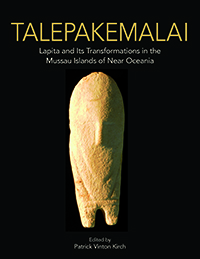Notes
Frequency percentages of grain types in Type J quartzose-feldspathic tempers based on band traverse counts of 400 grains per thin section. VRF is volcanic lithic fragments.
*Recalculated exclusive of 3% calcareous grains; also includes 1% aggregate epidote grains
Item record
Documentation
Temper Methods
Many Eloaua and Emananus sherds contain calcareous temper, composed of reef detritus, which is undiagnostic of specific geographic origin within tropical Oceania (Dickinson 1998b; Dickinson and Shutler 2000). Preliminary study of terrigenous (non-calcareous) tempers in 12 sherds from site ECA indicated that at least two temper types exotic to Mussau are present (Dickinson 2000). Chapter 12, based on petrographic examination of an additional 49 sherds (total sample of 61 sherds) in thin section, is a more definitive appraisal of the full array of Eloaua-Emananus temper types, which jointly document ceramic transfer to the Mussau Group from multiple unknown localities within the Bismarck Archipelago. The Mussau ceramic assemblage differs significantly in character from those of other known Lapita cultural centers within the Bismarck Archipelago, where most wares were made locally or transported only short distances from major islands to nearby offshore islets (Summerhayes 2000a; Thomson and White 2000).
The studied sherds include the full range of temper types separable megascopically in Lapita sherds from two localities with site ECA (the Area B Extension and Area C) on Eloaua Island, and from site EHB (Units TP1 and TP2) at Etapakengaroasa on Emananus Island (Kirch 1987a, 1988b; Kirch et al. 1991; Kirch 2001a). Sherds for thin-sectioning and petrographic analysis were selected in close consultation with Patrick Kirch during a visit by Dickinson to the Oceanic Archaeology Laboratory in December 2002. All diagnostic sherds from the Area B Extension and from Area C were first examined for macroscopic evidence of temper. Nine sherds from Area B Extension with evident calcareous sand temper (CST) were selected for petrographic study, as representative of the CST temper type. An additional 40 sherds with evident non-CST temper were then selected for thin-sectioning and petrographic study. The appendix to chapter 12 lists all of the 49 sherds sampled in 2002, with notes on sherd type and decoration.
Reuse
Dickinson, William R., 2021. Table S12.7. Frequency percentages of grain types in Type J quartzose-feldspathic tempers for Talepakemalai: Lapita and its Transformations in the Mussau Islands of Near Oceania. Version 1. Cotsen Institute of Archaeology Press. https://doi.org/10.25346/S6/0BCHCS
